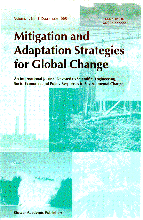| Journal Article |
 |
|
| Article Title | Smallholder agroforestry systems for carbon storage | | Author | James M Roshetko, Rodel D. Lasco and Marian delos Angeles | | Year | 2006 | | Journal Title | Mitigation and Adaptation Strategies for Global Change | | Institution | Springer-Verlag | | Pages | 1573-1596 | | Call Number | JA0223-06 | | Keywords | Enabling conditions, Local livelihoods, Smallholder agroforestry, Agroforestation , Smallholder CDM projects, AR CDM, LULUCF, CERs, C stocks, Transaction costs | | Notes | DOI: 10.1007/s11027-005-9010-9 |
|
| Abstract: |
| Most smallholder agroforestry systems in Southeast Asia are tree- and species-rich systems producing non-wood and wood products for both home use and market sale. Due to their high biomass, these systems contain large carbon (C) stocks. While the systems of individual farmers are of limited size, on a per area basis smallholder systems accumulate significant amounts of C, equaling the amount of C stored in some secondary forests of similar age. Their ability to simultaneously address smallholders’ livelihood needs and store large amounts of C makes smallholder systems viable project types under the Clean Development Mechanism (CDM) of the Kyoto Protocol, with its dual objective of emissions reduction and sustainable development. Smallholder systems have not developed in areas where enabling conditions do not exist. A CDM project that facilitates a minimum threshold of enabling conditions that make smallholder agroforestation possible should qualify for C credits. To secure smallholder confidence, the agroforestry systems promoted through a CDM project must be socially and economically viable independent of C payments. To assure system productivity and profitability, projects should provide farmers with technical and marketing assistance. Additionally, project sites should meet the following preconditions: areas of underutilized low-biomass landuse systems available for rehabilitation; smallholders interested in tree farming; accessible markets for tree products; supportive local governments; sufficient infrastructure; and transparent and equitable relationships between project partners. Questions of leakage and additionality should not be problematic and can be addressed through the project design, establishment of quantifiable baseline data and facilitating enabling conditions. However, smallholder-focused CDM projects would have high transaction costs. The subsequent challenge is thus to develop mechanisms that reduce the costs of: (a) making information (e.g., technology, markets) more accessible to multiple clients; (b) facilitating and enforcing smallholder agreements and (c) designing feasible monitoring systems. |
|
|
Download file(s): Click icon to download/open file.
|
| |
File Size |
Description |

|
- |
URL to document |
|
|
|
| Viewed in 2289 times. Downloaded in 707 times. |